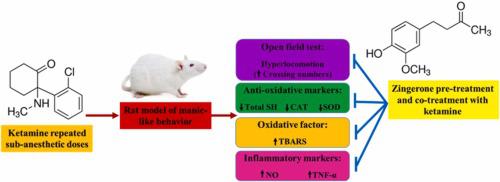Learning and Motivation ( IF 1.488 ) Pub Date : 2023-09-09 , DOI: 10.1016/j.lmot.2023.101934 Mahsa Maleki , Mehrnoosh Moosavi , Leila Zeidooni , Reza Azadnasab , Mohammad Javad Khodayar

|
Bipolar disorder (BD), before known as manic depression, is a chronic illness and a mood disorder characterized by manic and depressive periods. Drugs used to treat bipolar disorder can cause side effects if used chronically. Therefore, new therapeutic approaches are needed for treatment of BD. Given that inflammatory parameters and oxidative markers increase in BD and on the other hand there are a lot of evidences that zingerone (ZGR) has antioxidant and anti-inflammatory effects, the aim of this study was to investigate the neuroprotective effects of ZGR as one of the active phytochemicals existing in ginger in a model of manic-like behavior (MLB) induced by ketamine (KET) in rats. Thirty-six rats were randomly divided into six groups, including three groups of healthy rats: control, lithium chloride (LiCl) (45 mg/kg, p.o.) and ZGR (50 mg/kg, p.o.), and three groups of MLB rats (received 25 mg/kg KET, i.p. from day 8 to day 15): control, lithium (45 mg/kg, p.o.) and ZGR (50 mg/kg, p.o.). Pre-treatment with ZGR (50 mg/kg) once daily or LiCl (45 mg/kg) twice a day for 14 days prevented all KET-induced changes except total sulfhydryl content (total SH), which was not significant. The data of this study showed that 25 mg/kg KET increased the number of crossings in the open-field test and induced oxidative and inflammatory damage in the rat hippocampus (HPC) and prefrontal cortex (PFC). KET increased thiobarbituric acid reactive substances (TBARS), nitric oxide (NO), and tumor necrosis factor-alpha (TNF-α) levels; and decreased the activity of catalase (CAT) and superoxide dismutase (SOD) enzymes as well as the amount total SH in the HPC and PFC. These findings suggest that oxidative stress (OS) and inflammation may play an important role in BD, and ZGR as an anti-inflammatory and antioxidant agent might be able to reduce the oxidative and inflammatory damage related to the manic phase of this disorder.
中文翻译:

姜油酮对氯胺酮诱导的躁狂样行为大鼠模型的神经保护作用
双相情感障碍(BD),以前称为躁狂抑郁症,是一种慢性疾病和情绪障碍,以躁狂和抑郁期为特征。如果长期使用用于治疗双相情感障碍的药物可能会产生副作用。因此,需要新的治疗方法来治疗BD。鉴于 BD 中炎症参数和氧化标记物增加,另一方面有大量证据表明姜油酮 (ZGR) 具有抗氧化和抗炎作用,本研究的目的是研究 ZGR 作为一种神经保护作用。躁狂行为模型中生姜中存在的活性植物化学物质(MLB) 由氯胺酮 (KET) 在大鼠中诱导。将 36 只大鼠随机分为 6 组,包括 3 组健康大鼠:对照组、氯化锂(LiCl)(45 mg/kg,po)和 ZGR(50 mg/kg,po),以及 3 组 MLB 大鼠(第 8 天至第 15 天腹腔注射 25 mg/kg KET):对照、锂(45 mg/kg,口服)和 ZGR(50 mg/kg,口服)。用 ZGR(50 mg/kg)每天一次或 LiCl(45 mg/kg)每天两次预处理,持续 14 天,可以防止 KET 引起的所有变化,但总巯基含量(总 SH)除外,但不显着。本研究的数据显示,25 mg/kg KET 增加了旷场测试中的交叉次数,并诱导大鼠海马(HPC)和前额皮质的氧化和炎症损伤(PFC)。KET 增加硫代巴比妥酸反应物质 (TBARS)、一氧化氮 (NO) 和肿瘤坏死因子-α (TNF-α) 水平;并降低过氧化氢酶的活性以及 HPC 和 PFC 中的总 SH 量。这些发现表明,氧化应激 (OS) 和炎症可能在 BD 中发挥重要作用,而 ZGR 作为抗炎和抗氧化剂可能能够减少与这种疾病的躁狂期相关的氧化和炎症损伤。



























 京公网安备 11010802027423号
京公网安备 11010802027423号